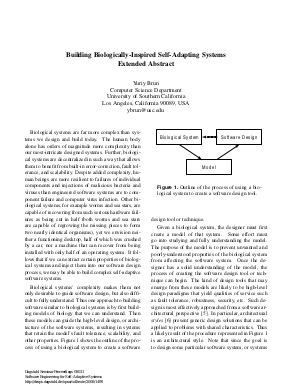Building Biologically-Inspired Self-Adapting Systems
Author Yuriy Brun
-
Part of:
Volume:
Dagstuhl Seminar Proceedings, Volume 8031
Part of: Series: Dagstuhl Seminar Proceedings (DagSemProc) - License:
 Creative Commons Attribution 4.0 International license
Creative Commons Attribution 4.0 International license
- Publication Date: 2008-05-27
File

PDF
DagSemProc.08031.3.pdf
- Filesize: 49 kB
- 2 pages
Document Identifiers
Subject Classification
Keywords
- Biologically-inspired
- software architecture
- fault tolerance
- scalability
Metrics
- Access Statistics
-
Total Accesses (updated on a weekly basis)
0Document
0Metadata
Abstract
Biological systems are far more complex than systems we design and build today. The human body alone has orders of magnitude more complexity than our most-intricate designed systems. Further, biological systems are decentralized in such a way that allows them to benefit from built-in error-correction, fault tolerance, and scalability. It follows that if we can extract certain properties of biological systems and inject them into our software design process, we may be able to build complex self-adaptive software systems. Biological systems’ complexity makes them not only desirable to guide software design, but also difficult to fully understand. Thus one approach to building software similar to biological systems is by first building models of biology that we can understand. Then these models can guide the high-level design, or architecture of the software systems, resulting in systems that retain the model’s fault tolerance, scalability, and other properties. I present a general outline of how one might use biology to create a model to guide the architecture of a software system, and develop one such model and the resulting architectural style, the tile style, for computational systems that can use a large distributed network of computers, such as the internet, to solve computationally-intensive problems in a discreet, fault-tolerant, and scalable manner.
Cite As Get BibTex
Yuriy Brun. Building Biologically-Inspired Self-Adapting Systems. In Software Engineering for Self-Adaptive Systems. Dagstuhl Seminar Proceedings, Volume 8031, p. 1, Schloss Dagstuhl – Leibniz-Zentrum für Informatik (2008)
https://doi.org/10.4230/DagSemProc.08031.3
BibTex
@InProceedings{brun:DagSemProc.08031.3,
author = {Brun, Yuriy},
title = {{Building Biologically-Inspired Self-Adapting Systems}},
booktitle = {Software Engineering for Self-Adaptive Systems},
pages = {1--1},
series = {Dagstuhl Seminar Proceedings (DagSemProc)},
ISSN = {1862-4405},
year = {2008},
volume = {8031},
editor = {Betty H. C. Cheng and Rogerio de Lemos and Holger Giese and Paola Inverardi and Jeff Magee},
publisher = {Schloss Dagstuhl -- Leibniz-Zentrum f{\"u}r Informatik},
address = {Dagstuhl, Germany},
URL = {https://drops.dagstuhl.de/entities/document/10.4230/DagSemProc.08031.3},
URN = {urn:nbn:de:0030-drops-14991},
doi = {10.4230/DagSemProc.08031.3},
annote = {Keywords: Biologically-inspired, software architecture, fault tolerance, scalability}
}
